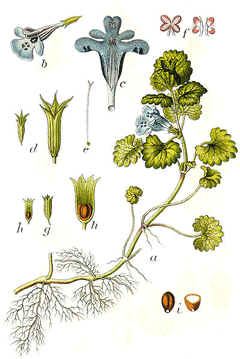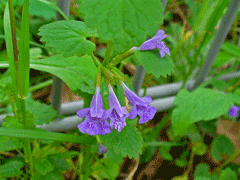 |
|
http://commons.wikimedia.org/wiki/File:Glechoma_hederacea_Sturm27.jpg |
 |
| http://commons.wikimedia.org/wiki/User:Llez |
Translate this page:
Summary
Bloom Color: Lavender. Main Bloom Time: Late summer, Mid summer. Form: Prostrate, Spreading or horizontal.
Physical Characteristics

 Glechoma hederacea is an evergreen Perennial growing to 0.2 m (0ft 8in) by 1 m (3ft 3in) at a fast rate.
Glechoma hederacea is an evergreen Perennial growing to 0.2 m (0ft 8in) by 1 m (3ft 3in) at a fast rate.
It is not frost tender. It is in leaf all year, in flower from March to May. The species is hermaphrodite (has both male and female organs) and is pollinated by Bees.
It is noted for attracting wildlife.
Suitable for: medium (loamy) and heavy (clay) soils and can grow in heavy clay soil. Suitable pH: mildly acid, neutral and basic (mildly alkaline) soils. It can grow in semi-shade (light woodland) or no shade. It prefers moist soil.
UK Hardiness Map
US Hardiness Map
Synonyms
Nepeta glechoma. N. hederacea. Calamintha hederacea. Chamaecissos hederaceus.
Plant Habitats
Woodland Garden Dappled Shade; Shady Edge; Ground Cover; Hedgerow;
Edible Uses
Edible Parts: Leaves
Edible Uses: Condiment Tea
Young leaves - raw or cooked[9]. The leaves have a bitter flavour[5], they can be mixed into salads to add a slight aromatic tang[7]. They can also be cooked like spinach, added to soups etc or used as a flavouring[2, 183]. Available very early in the year. A herb tea is made from the fresh or dried leaves[2, 177, 183]. It is often used mixed with verbena leaves[7]. The herb has been added to beer in much the same way as hops in order to clear it and also to improve its flavour and keeping qualities[4, 183]. This species was the most common flavouring in beer prior to the use of hops from the 16th century onwards[238].
References More on Edible Uses
Medicinal Uses
Plants For A Future can not take any responsibility for any adverse effects from the use of plants. Always seek advice from a professional before using a plant medicinally.
Anodyne Antidiarrhoeal Antiphlogistic Antirheumatic Appetizer Astringent Digestive Diuretic
Febrifuge Miscellany Pectoral Stimulant Tonic Vermifuge
Ground ivy is a safe and effective herb that is used to treat many problems involving the mucous membranes of the ear, nose, throat and digestive system[254]. A well-tolerated treatment it can be given to children to clear lingering catarrh and to treat chronic conditions such as glue ear and sinusitis[254]. Throat and chest problems, especially those due to excess catarrh, also benefit from this remedy[254]. The leaves and flowering stems are anodyne, antiphlogistic, appetizer, astringent, digestive, diuretic, febrifuge, pectoral, gently stimulant, tonic and vermifuge[4, 9, 21, 100, 147, 165, 178]. They are best harvested in May whilst still fresh[4], and are dried for later use[238]. The leaves are used in the treatment of hypersensitivity in children and are useful in the treatment of kidney diseases and indigestion[4, 9, 21, 100, 147, 165, 178]. Applied externally, the expressed juice speeds the healing of bruises and black eyes[4]. Use with caution[21].
References More on Medicinal Uses
The Bookshop: Edible Plant Books
Our Latest books on Perennial Plants For Food Forests and Permaculture Gardens in paperback or digital formats.

Edible Tropical Plants
Food Forest Plants for Hotter Conditions: 250+ Plants For Tropical Food Forests & Permaculture Gardens.
More

Edible Temperate Plants
Plants for Your Food Forest: 500 Plants for Temperate Food Forests & Permaculture Gardens.
More

More Books
PFAF have eight books available in paperback and digital formats. Browse the shop for more information.
Shop Now
Other Uses
References More on Other Uses
Cultivation details
Landscape Uses:Container, Ground cover. Prefers a heavy soil and dappled shade[17, 31]. Prefers a moist well-drained soil, succeeding in sun or shade[188]. A very invasive plant, spreading freely at the roots[1, 31, 238]. A good bee plant[108]. Special Features:Attractive foliage, Fragrant foliage, Not North American native, Naturalizing, Attractive flowers or blooms. In garden design, as well as the above-ground architecture of a plant, root structure considerations help in choosing plants that work together for their optimal soil requirements including nutrients and water. The root pattern is rhizomatous with underground stems sending roots and shoots along their length [2-1].
References Carbon Farming Information and Carbon Sequestration Information
Temperature Converter
Type a value in the Celsius field to convert the value to Fahrenheit:
Fahrenheit:
The PFAF Bookshop
Plants For A Future have a number of books available in paperback and digital form. Book titles include Edible Plants, Edible Perennials, Edible Trees,Edible Shrubs, Woodland Gardening, and Temperate Food Forest Plants. Our new book is Food Forest Plants For Hotter Conditions (Tropical and Sub-Tropical).
Shop Now
Plant Propagation
Seed - we have no information for this species but suggest sowing the seed in situ as soon as it is ripe, or in the spring. Division in spring or autumn[188]. Very easy, larger clumps can be replanted direct into their permanent positions, though it is best to pot up smaller clumps and grow them on in a cold frame until they are rooting well. Plant them out in the spring.
Other Names
If available other names are mentioned here
Ground Ivy, Field Balm, Gill Over The Ground, Runaway Robin
Native Range
TEMPERATE ASIA: Turkey, Russian Federation-Ciscaucasia (Ciscaucasia), Azerbaijan, Georgia, Russian Federation (Dagestan), Russian Federation-Western Siberia (Western Siberia), Russian Federation-Eastern Siberia (Eastern Siberia), Kazakhstan (southeast), China (Xinjiang Uygur Zizhiqu) EUROPE: Denmark, Finland, United Kingdom, Ireland, Norway, Sweden, Czechoslovakia, Austria, Belgium, Switzerland, Germany, Hungary, Netherlands, Poland, Russian Federation (European part), Belarus, Estonia, Lithuania, Latvia, Moldova, Ukraine (incl. Krym), Former Yugoslavia, Albania, Bulgaria, Greece, Italy, Romania, Spain, France (incl. Corsica), Portugal
Weed Potential
Right plant wrong place. We are currently updating this section.
Please note that a plant may be invasive in one area but may not in your area so it's worth checking.
Conservation Status
IUCN Red List of Threatened Plants Status :

Growth: S = slow M = medium F = fast. Soil: L = light (sandy) M = medium H = heavy (clay). pH: A = acid N = neutral B = basic (alkaline). Shade: F = full shade S = semi-shade N = no shade. Moisture: D = dry M = Moist We = wet Wa = water.
Now available:
Food Forest Plants for Mediterranean Conditions
350+ Perennial Plants For Mediterranean and Drier Food Forests and Permaculture Gardens.
[Paperback and eBook]
This is the third in Plants For A Future's series of plant guides for food forests tailored to
specific climate zones. Following volumes on temperate and tropical ecosystems, this book focuses
on species suited to Mediterranean conditions—regions with hot, dry summers and cool, wet winters,
often facing the added challenge of climate change.
Read More
Expert comment
Author
L.
Botanical References
17
Links / References
For a list of references used on this page please go here
Readers comment
| Add a comment |
|
If you have important information about this plant that may help other users please add a comment or link below. Only comments or links that are felt to be directly relevant to a plant will be included. If you think a comment/link or information contained on this page is inaccurate or misleading we would welcome your feedback at [email protected]. If you have questions about a plant please use the Forum on this website as we do not have the resources to answer questions ourselves.
* Please note: the comments by website users are not necessarily those held by PFAF and may give misleading or inaccurate information.
To leave a comment please Register or login here All comments need to be approved so will not appear immediately.
|
Subject : Glechoma hederacea
|
|
|
|